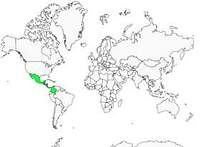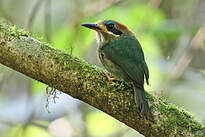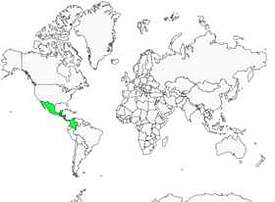Tody Motmot
Hylomanes momotula - Motmot nain
Identification
Hylomanes momotula, the first part of the scientific name coming from the Greek word hulos, meaning forest and mania, meaning passion, our Tody Motmot is a passionate of the forest! Ornithology is a science, however sometimes taxonomy begins with a spelling mistake! The first Tody Motmot was certainly seen by a Spanish naturalist, Francisco Hernandez (1514-1578) who conducted the first scientific expedition in Central America. When he returned to Spain, another Spanish naturalist, Juan Eusebio Nieremberg y Ottin (1595-1658) copied the descriptions of his colleague by making a spelling mistake: momot will become Tody Motmot. Studies done on the work of Francisco Hernandez show that he used the language Nahuatl spoken by the Aztecs to describe the birds, momot coming from momotla which can be translated as one who throws himself to the ground and which describes the hunting behavior of the Tody Motmots. The Tody Motmot is the smallest of the species, from 16 to 18 cm, the head is voluminous, the slightly curved beak is strong and long with a black upper jaw, the lower jaw being beige. The base of the whitish-cream forehead extends under the huge black eye with a large line of the same color and the thick black eyebrow line makes up the back of the eye, the turquoise-blue eyebrows bring a colorful and luminous touch to the head. The crown and the nape are brownish-chestnut while the mantle and the back take on a dark green color, the great coverings and the wing feathers darken and become gray-green; the throat is whitish and the breast hesitates between green and gray-green, the belly turning to a dirty white color. The tail is very short, the central feathers remain greenish and the outer feathers are gray, the tarsi are light brown to dark brown. The dimorphism is mainly marked by the size, the female being smaller, the juveniles have a hesitant and quite dull coloring, the crown and the nape are pale gray-brown.There are three subspecies recognized, Hylomanes momotula from which the species gets its name, ssp chiapensis which has the same colors but darker, and ssp obscurus which accentuates the phenomenon and is even darker than chiapensis.
Subspecific information 3 subspecies
- Hylomanes momotula momotula (Veracruz. s Mexico. to Honduras)
- Hylomanes momotula chiapensis (Chiapas. s Mexico.)
- Hylomanes momotula obscurus (nw Costa Rica to nw Colombia)
Foreign names
- Motmot nain,
- Momoto enano,
- udu-miudinho,
- Zwergmotmot,
- törpemotmot,
- Kleine Motmot,
- Motmot todo,
- dvärgmotmot,
- Dvergmotmot,
- momot trpasličí,
- momot trpasličí,
- Todimotmot,
- pikkumomotti,
- motmot menut,
- piłodziób płaskodzioby,
- mali motmot,
- Малый момот,
- コハチクイモドキ,
- 短尾翠鴗,
- dvärgmotmot,
- 短尾翠鴗,
Voice song and call
Habitat
Dietfeeding habits
The Tody Motmot is an insectivore: spiders, all types of insects, butterflies, and especially the large Morphos of Central and South America are on its menu, but it won't snub snails or small lizards either. It hunts perched on low branches from which it dives to the ground to capture its prey, but we also know that it captures dragonflies or butterflies in flight.
Reproduction nesting
Geographic range
Tody Motmot Ssp momotula is found in the south of Mexico, in the provinces of Veracruz and Oaxaca, as well as to the east of Nicaragua and northwest of Costa Rica; ssp chiapensis has a fragmented range, in the south of Mexico in the Pacific part of Chiapas up to the extreme west of El Salvador; ssp obscurus is found in Panama and in the extreme west of Colombia.
Threats - protection
IUCN conservation status
concern
in the Wild
threatened
evaluated
LC: the Tody Motmot is one of the birds we all dream of seeing, its taste for very shady parts of the canopy makes it virtually invisible, its size and plumage make it look like a leaf and when you manage to spot it, taking a photo is almost impossible because it stays hidden from the light. We know almost nothing about it, and maybe that's for the better, its discretion is its best protection!
Sources of information
- IOC World Bird List (v15.1), Gill, F and D Donsker (Eds). 2025-12-07.
- Vol. 6 - Handbook of the Birds of the World, Josep del Hoyo-Andrew Elliott-Jordi Sargatal
- Scientific Birds Names, James A.Jobling
- Histoire de l'ornithologie, Valérie Chansigaud
- xeno-canto, Sharing bird sounds from around the world,
- Avibase, Lepage Denis
- BirdLife International, BirdLife International
- HBW Alive,
- Neotropical Birds Online,
- Wikipédia, Wikipedia, The Free Encyclopedia
Other sources of interest
 Specification sheet created on
01/08/2023 by Anne et Gabriel Leboff
Specification sheet created on
01/08/2023 by Anne et Gabriel LeboffTranslation by AI Oiseaux.net
© 1996-2025 Oiseaux.net
- Accipitriformes
- Aegotheliformes
- Anseriformes
- Apodiformes
- Apterygiformes
- Bucerotiformes
- Caprimulgiformes
- Cariamiformes
- Casuariiformes
- Charadriiformes
- Ciconiiformes
- Coliiformes
- Columbiformes
- Coraciiformes
- Cuculiformes
- Eurypygiformes
- Falconiformes
- Galliformes
- Gaviiformes
- Gruiformes
- Leptosomiformes
- Mesitornithiformes
- Musophagiformes
- Nyctibiiformes
- Opisthocomiformes
- Otidiformes
- Passeriformes
- Pelecaniformes
- Phaethontiformes
- Phoenicopteriformes
- Piciformes
- Podargiformes
- Podicipediformes
- Procellariiformes
- Psittaciformes
- Pterocliformes
- Rheiformes
- Sphenisciformes
- Steatornithiformes
- Strigiformes
- Struthioniformes
- Suliformes
- Tinamiformes
- Trogoniformes















